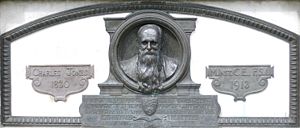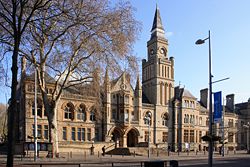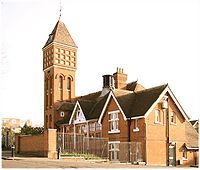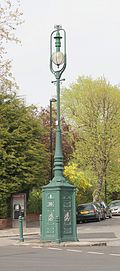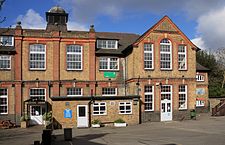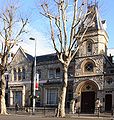- Charles Jones (architect)
-
Charles Jones (1830–1913) was Ealing's first architect, engineer and surveyor. He held these posts for fifty years.[1] He is admired to this day, by both local residents and visitors, for his pleasing, well proportioned and functional civic buildings. He first started working for the Council on a commission only basis in 1863 until he was given a salaried post in 1882, which he held until he retired in 1913, shortly before his death the same year.
Contents
Civic Buildings
His most prominent work is that of Ealing Town Hall. Before building could go ahead, Jones also had to find the land and negotiate the purchase. In 1885 he finally persuaded Edward Wood to sell his whole meadow which lay between the Uxbridge Road and the Great Western Railway cutting and alongside the very old road of Longfield Avenue. Being on such a busy thoroughfare, next to the new town centre and so close to both of Ealing's railway stations it was very much a prime site. Even so, Jones was able to persuade Wood to part with the land for only £4,000 (well below its market value) on the understanding that it would always remain council property for public buildings guaranteed by Deed of Covenant. This was indeed fortunate, as it allowed the building to be later extended on its east side and to have room behind for three municipal public swimming baths (Wood went on to donate a further £500 for the building of Victoria Hall).[2][3]
It is in the "Revived Gothic" style with Kentish ragstone walls. Fine-grained Bath Stone has been used for the molding around the windows. It was completed for a cost of £16,000. English Heritage has classified it as a Grade II listed building.[4]
As the population grew, so did the need for a large function room. The necessary funds for building were found by public subscription. In order to secure generous patronage from wealthy residents, Jones needed to make it look as grand as possible. Also, he needed to span a reasonably wide expanse of area without recourse to vertical roof supports. Jones solved both requirements by basing the roof construction on medieval 14th century baronial architecture. It features wall-posts supporting moulded hammer-beams, and curved braces. The king post are hidden above the ceiling, which is on the level of the horizontal ties, these stop the roof collapsing in upon itself. By this means, Jones was able to span a width of 45½ feet. The hall is some 74-foot (23 m) long; with a stage at one end. Around the top of the room are the shields and emblems of the various parishes and former municipal councils which amalgamated to form the present borough. The window are glazed with stained glass. As usual for halls of this type, a room, was also built below (the Princes room), not just for the economic advantage of using the same land footprint, but also to ensure that the room above could be held at a reasonable temperature. Otherwise the sudden increase in moisture from a large crowd of people would cause heavy condensation to form upon the chill floor. It is built onto the back of the town hall's municipal buildings. The wall facing the street are in the same Gothic style to match that of the town hall. It was named Victoria Hall to celebrate Queen Victoria's 1837 – 1887 Golden Jubilee. It was officially opened on December 15, 1888 by Edward, Prince of Wales (later Edward VII).[1] Adjoining town hall, it is part of the same Grade II listed structure.
The original council offices before this, which he also designed in Gothic, lay 500 yards (460 m) further east along the Uxbridge Road. The premises are now occupied by a bank. English Heritage has classed it as a Grade II listed building.[4]
Civic infrastructure
His first work for the council in 1863 was to lay out the towns first proper sewage system. As the Thames at this time suffered from gross pollution from raw sewage he also, designed a sewage farm to treat the effluent; this was built at Clayponds down Occupation Lane just off of South Ealing Road. Over the next two decades this was step mentally expanded to cope with the rapidly expanding population.
To go behind the new Town Hall he designed a fire engine station. The building is still in existence but has long ceased to be used for its original purpose. Whilst not thought notable enough to warrant statutory protection, it has nevertheless been 'locally listed' by Ealing Council as being of architectural interest.[5][6]
Another task he was charged with, was to design and oversee the first Electricity Generating Station and distribution system which came on line in 1894 and provided Ealing with its first electric street lighting. This was also situated down occupation Lane. The sludge from the sewage farm next door, was filtered out and burnt here as fuel to provide power.
During this time the council was also purchased some of the properties off local notabilities which came with large plots of open land. Jones oversaw the work of turning these into public pleasure parks. He was also responsible for having the Chestnut tree avenues planted on Ealing Common which gave it much of its present day caricature.[1]
He also designed the redevelopment of Pitzhanger Manor in order that it could become a free public lending library. Opening in April 1902, it remained Ealing's Central Library until it moved in 1985. Because of Jones's sympathetic alterations to the original site, it was possible to then restore the house to reflect as accurately as practical, how it would have looked in the 1800s. Today it is a museum and art gallery open to the public at no charge. English Heritage has classed it as a Grade I listed building.[4]
Churches
An early design of Jones's was the Congregational Church (1860) on Ealing Green (now the United Reformed and Methodist Church). Style: Gothic.[7]
Methodist Church (1869) at the north end of Windsor Road just before the Junction of Uxbridge Road. Style: Gothic. This now a Polish Roman Catholic Church of 'Our Lady Mother of the Church'. [8] [9] English Heritage has classified it as a Grade II listed building.[4]
Schools
To comply with the first education acts the council had to use whatever buildings were available in which to hold lessons. Jones then set about designing the borough first purpose built State schools. He undertook the designs of Drayton Green (1908) (see below), Lammas (1910)[demolished], Little Ealing (1905)[see below], North Ealing Primary School (1911) in Pitshanger Village, and Northfields (1905) [demolished].
Drayton Green
Drayton Green Primary School (pictured) at the terminus of Drayton Grove, Ealing W13 London has been built in yellow brick, with red brick dressing and featuring keystoned window arches. A centrally placed, square-shaped, part-louvered, cupola bell house -sits on the red terracotta tiled roof. It provides a very good example, of typical late-Victorian architecture. [1][10]
Little Ealing Primary School
Little Ealing Primary School, Weymouth Avenue, Ealing, London, W5 4EA. Single story, yellow brick with key-stoned arched windows and terracotta tiled roof. The main hall is baronial in style with wall post supporting the hammer beams and curved braces. At each end of the long corridor, white hexagonal ventilation cupolas sit in the roof. From the horizontal ties upwards both these roofs are glazed.
Private projects
He took advantage of rapidly increasing housing costs by accepting board membership of the Ealing, Acton & Hanwell Permanent Benefit Building Society.[1]
When land up at Castle Bar belonging to the former Prince Edward Augustus, Duke of Kent and Strathearn home (Kent House) was sold off , Jones purchased much of it for his own private house building projects. He did this in the face of competition from the newly formed housing associations such as the Ealing Tenants Association who where buying up land, on which to build cheap houses for the working classes.
Other posts
He was also a member of the first Local Board of Health. It was an essential for him to join this local health board. For it was only by engineers, politicians and medical scientists combining their skills together, that all the measure needed to resist the spread of water born disease, and repeated epidemics from such diseases, could these measures be integrated, planned and actioned.
On a wider front, he was a founding member and the first honorary secretary of the Institute of Municipal and County Engineers.[1]
Publications
Jones published three books:
- 20 Years Development of a London Suburb. 1884.
- Ealing: From Village to Corporate Town. Publ. Spaul, 1904.
- Decade of Progress 1901–1911. 1911.
Further examples of his surviving work
Notes
- ^ a b c d e f Hounsell, Peter (1991). Ealing and Hanwell Past. London: Historical Publ. pp. 66,75,80,83,85,86,94,127. ISBN 0-948667-13-3.
- ^ McEwan, Kate (1983). Ealing Walkabout: Journeys into the history of a London borough.. Cheshire, UK.: Nick Wheatly Associates. pp. 62. ISBN 0 9508895 0 4.
- ^ Dan Hodges (2008-08-29) Doubt cast over plans. page 1. Ealing and Acton Gazette.
- ^ a b c d Ealing’s New Plan for the Environment, volume 2, Chapter 10.9 Statutory Listed Buildings and Ancient Monuments. The statutory List of Buildings of Special Architectural or Historic Interest prepared by the Department of the Environment. Accessed 2008-04-19
- ^ Ealing’s New Plan for the Environment, volume 2 Chapter 10.10 Locally Listed Buildings. Prepared by the Borough, buildings of architectural or historical interest. Accessed 2008-04-19
- ^ 'Ealing and Brentford: Social and cultural activities', A History of the County of Middlesex: Volume 7: Acton, Chiswick, Ealing and Brentford, West Twyford, Willesden (1982), pp. 120-123. Date accessed: 10 April 2008.
- ^ Ealing Green Church official web site. Accessed 2008-04-12.
- ^ Our Lady Mother of the Church official web site. Accessed 2008-04-12.
- ^ Ealing Civic Society official web site.Accessed 2008-04-12.
- ^ Ealing and Brentford: Education, A History of the County of Middlesex: Volume 7: Acton, Chiswick, Ealing and Brentford, West Twyford, Willesden (1982). pp. 162-170. Date accessed: 09 April 2008.
References
- Ealing and Brentford: Education, A History of the County of Middlesex: Volume 7: Acton, Chiswick, Ealing and Brentford, West Twyford, Willesden] (1982), pp. 162-170. Date accessed: 26 March 2008.
- Ealing and Brentford: Local government, A History of the County of Middlesex: Volume 7: Acton, Chiswick, Ealing and Brentford, West Twyford, Willesden (1982), pp. 144-147. Date accessed: 26 March 2008.
- Hounsell, Peter. Ealing and Hanwell Past. London: Historical Publications, 1991. ISBN 0-948667-13-3.
Categories:- British architects
- 1830 births
- 1913 deaths
- History of Ealing
Wikimedia Foundation. 2010.

